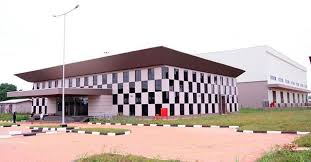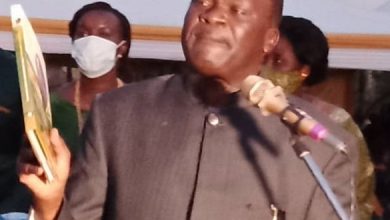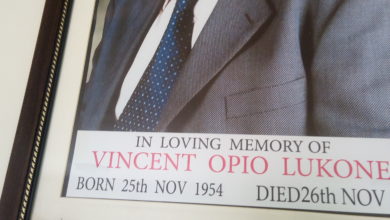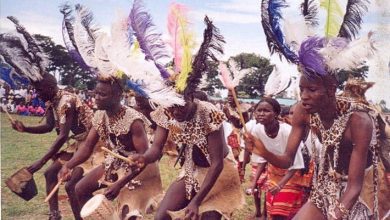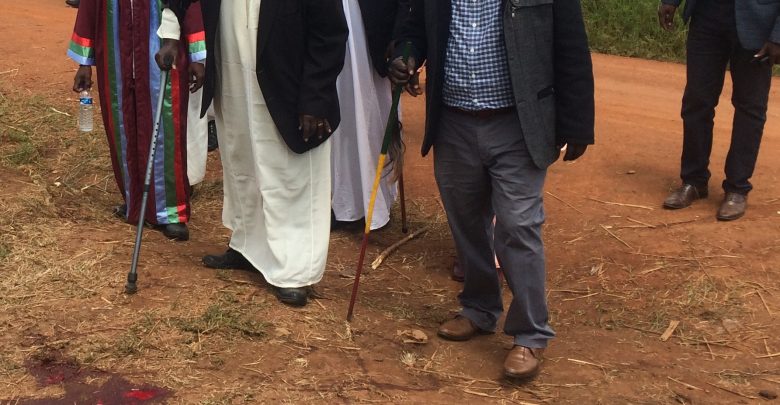
Uncategorized
UGANDA: AFRICAN CULTURE AT CROSS ROAD WITH WESTERN CULTURE AS ACHOLI CHIEFS ROOT BACK TO AFRICAN FAITH
Acholi paramount chiefs step on ram blood as a requirement to pay respect to the fallen Clan Chief of Bwobo Pai-bwo, Rwot Ojok Michael Aginya.
NWOYA DISTRICT-NORTHERN UGANDA, AUGUST 3, 2024
The African traditions is at cross road with western cultural beliefs, just over a century since European captured the interior of the dark continent of Africa with introduction of western cultural believes, African religion continue to erode as the clock tick’s.
August 3, 2024, Lawirwodi, Rwot Richard Santo Apire and dozens of Acholi chiefs made history by stepping on the blood of Ram, as they cross blood to bury Rwot Michael Ojok Aginya, hundreds of on lookers’ gleefully watching unfolding event at 11.30AM local African time before retired Rev. Okoyo of the Anglican Church of Uganda began officially conducting the veneration.
Before walking on blood, the motorcades of Lawirwodi, Rwot Richard Santo Apire stopped at (Wang Kac), entrance of decimated ancestral burial site, and all the chief disembarked from their vehicles, walked in groups descending Ram blood to purify them as the traditional cultural norm dictates that no chief would go to attend burial. Unless otherwise the Ram is slaughtered, the blood of Ram cleanses them from abomination that would have befallen them.
Rwot John Ogenga Obita, the Deputy Lawirwodi says as traditional Acholi chiefs once they reach where death occurred is an abomination, even at his chiefdom, you are not supposed to touch the deceased body, unless Ram is slaughtered, in the same vein, chief do not fight or engage in verbal exchange of bitterness ‘it tantamount to curse on the victims, Rwot Obita explained.
Soon, Lawirwodi Santo Richard Apire crossed over to the burial ground, they were welcome, the prayer was announced by organizing committee that the teams of clergy was ready to conduct mass, and they had gone to change their cloths.
However order was issued by the council of chief of Bwobo, that the new crown chief of Bwobo, the son of Rwot Ojok Aginya who was crown fourth night ago as the new Rwot of Bwobo still on the way, masses has to be put on hold.
After 30 minutes, Rwot Aginya the II, his present was announced as Rwot Aginya II step also on the Ram’s blood, crossing over to attend his father’s burial. He was welcomed by all the chiefs, and directed where the remains of his father Rwot Aginya I body lay, his son the hire of the throne Rwot Aginya II was moved to touch his deceased father Rwot Aginya I.
Two weeks ago Rwot Aginya II was crowned in a ceremony witnessed by the Paramount Chief and Council of elders (In our next edition we will bring you a full detail of what transpired during the coronation).
This is to fulfill, the cultural traditions norms, by that time, the ghost, spirit of his late father Rwot Aginya I feel him and he assume the worldly of the (Ker Kwaro Bwobo) and later on he was announced and introduced to his subjects by Lawirwodi, Rwot Santo Richard Apire that that he is the new Rwot of Bwobo replacing the late Rwot Aginya I, Congregation welcomed him with ululation and blowing horns, while Acholi spiritual leader Francis Okello Mawa took mock fight celebration.
Western culture at play
CPATION (Lawirwodi, Rwot Richard Santo Apire and other chiefs step on Ram blood to cross over to bury Rwot Michael Ojok Aginya II)
At 1.00PM, Rev. Okoyo calls for payer, and he assembles clergies matching toward the temporary semi structure to begin processes prayer. But before that the groups royal Bwola dances were called as pre request, both African and Western religions now permit the two to function hand in hand.
And Bwobo Bwola traditional royal dancers was arranged, they came in with their royal dance………………..
That was Bwola song to welcome Rwot when his remains is appearing in public.
Thereafter, the Rev. Okoyo to keep track of the congregation Rev. Okoyo began his preaching, Rwot Owaco ni an acer ki kwo” literally, the Lord God says I am the light for you. The Lord God taken the life of Rwot Michael Ojok Aginya II, praise God. And asked for the first reading of Jabuli 23: to the end, which read by the family member, the second reading Roma 8:35-39. Was taken by one of the clergy man. The third reading of the Bible was taken from the book Mathew 11:25-30.
Later Rev. Okoyo called for master of ceremony to read the biography of the late Rwot Ojok Aginya II.
Odoch Erick, the master of ceremony who is the brother to the late, says the late Rwot Ojok Aginya was born in 2, November, 1973, died on 4th July 2024 at 12.PM local African time, he hailed from Bwobo-Pai Bwor Kal, his father Okello Venasio Drum meja Aginya I.
His education, in 1978-1981 he studied primary One to Primary 4 at Nwoya Primary school, in 1982-1983 he studied primary 5 at Nsambya Police school in Kampala, in 1984-1985 he studied primary 6-7 Masindi Army school, from 1986-1988 year1- year 2 Iganga Vocational Institute. And in 1990-1992 he joined Jinja Mechanic and driving, where completed his advance technical training.
His works experienced. From 1994-1999 Rwot Ojok Aginya I, joined the then National Resistance Army, (NRA,) now Uganda People Defense Forces (UPDF) as tanker driver, he worked in Uganda statehouse, trained in military intelligence in many countries.
In 2011, Ker Kwaro Bwobo, called him back to take the leadership of chiefdom and in 2012 he was crowned chief of Bwobo Pai-Bwo.
He survived with three wives and many children, 9 children were introduced before mourner including his elder son, hire of Bwobo Pai-Bow chiefdom Author Oyera, who is a police officer.
Rwot Ojok Aginya passed on from St Mary Lacor Hospital after one week when he was in Intensive care unit, before he died people back home were celebrating and passing information that he had died.
After the introduction, Rev. Okoyo in his summon preaches about love and hard work, he says in the past Acholi community would not condoned poverty, stealing, adultery, sexual immorality. But, today those vices are the norms in our daily life.
“I calls upon you to turn to Godly way, avoid being travel shooters, stop burglary, stop stealing, stop sexual immorality, listen to your parents as young children.” Rev. Okoyo appealed to congregation who sat attentively.
Finally, the retired Rev. Okoyo echoed that unless Acholi community go back and embraced Amb, Dr. Olara Otunnu, and Chief Justice, Alfonse Owiny Dollo Chigamoi calls for cultural revitalizations calls which was made last year in November 27-29, what became known as Pongdwongo declaration.
Later Rwot Ojok Aginya I was casket was escorted with Bwola traditional dances to his grave. (Too Okwanyo mega woko, pi otwero mega woko.) Literally Rwot Aginya was no more, his casket coffin was carried by elders from Bwobo clan, and lay to rest. But, later the coffin was adorned with black bull skin and Leopard skins were placed atop the coffin.
After the burial, Bwola dancers escorted Lawirwodi Santo Apire back to where they sat, in traditions Bwola song.
(Kili kili me ikma ni, Rwot onywalo Awobi, min awobi woto kinyate.) Literally the mother of chiefs walks majestically while escorting her newly crowned hire chief.
And upon, Lawirwodi Santo Apire introduced the legend Okello Charles of Rwot Oyera, says he does not have much to say, he thank Rev. Okoyo introduced the queen mother Achen Helen Oketta, to introduce a new Rwot who was anointed.
The legend Okello, introduce Rwot Oyera, and his council of chief, says God has taken Rwot Ojok Aginya…
Lawirwodi Santo Apire says on 14th June, 2024. He was elected Lawirwodi of Acholi Chiefdom, because in Acholi all chiefs have the same rights to administering their chiefdom in same vein,
Introducing all chiefs, beginning with Rwot Collin Atiko, Rwot John Ogenga of Labongo Amida, Rwot royi Lurengamoi of Namkora, Rwot Chwa, tira Obol, Obina Nelson Agole III rwot Pabbo, Odokonyero Alex Obige Obol Rwot pichor, Opira Laurence Kikwera Nono of Lukoung, Rwot Ongom Kashmir Rwot Patongo Agago, Rwot Solomon Oyat Oketta Rwot Koch, Godwin Okello Prime me Puranga, Collin Lukwyai, Rwot Ojara Justine of Rwot Ker Bwobo and Okello Francis Mawa.
Lawirwodi Rwot Apire warned those who are castigating his election, particularly those who are calling for peace talk between the former Lawirwodi Rwot Emeritus David Acana II.
“I want to tell you that Acholi does not have kingdom, and king as it has been allegedly purportedly being says by emeritus Rwot Acana.” Lawirwodi Santo Apire warned.
Amb. Dr. Olara Otunnu in his speech calls for unity among the chiefs says with all the progress Kacoke Pongdwongo made without unity among the chiefs, Acholi community will lose.
“I want to advice Acholi Ker Kwaro to unit, unless you have unity then we are going to achieve our objective, with divided chiefdom, we lose.” Amb. Olara Otunnu warned.
On Wednesday 31st July, 2024. Emeritus Archbishop John Baptist Odama, of Gulu Catholic Arch Dioceses organized mediation between the two warring factions, the elect Lawirwodi Richard Santo Apire and emeritus Rwot David Onen Acana II at St Monica Adel, Catholic, in Gulu City.
However, the Lawirwodi, Santo Apire team rejected the emeritus Archbishop John Baptist Odama’s call, on the ground that they don’t have issues to discuss with emeritus Rwot David Onen Acana since he was elected with majority of Acholi chiefs.
Highly placed source revealed that emeritus Archbishop John Baptist Odama is being used to popularize emeritus Rwot David Acana to appear among Acholi chiefs.
Previously, emeritus Archbishop Odama went to seek radiance with president Museveni and asked him to mediate between the two Acholi revivals Lawirwodi.
Robert Adonga Kulu, spokesperson for Ker Kwaro Acholi told The Guardians News Correspondent also have learned that Betty Amongi Akena, the Minister of Gender, Labour and Social Development is planning to come and meet the Lawirwodi Rwot Santo Apire and emeritus Lawirwodi Rwot Acana II, and she will use that opportunity to call for an election, since he has been popularized Acholi chiefs pro emeritus Rwot Acana, they vote out Lawirwodi Santo Apire.
Emeritus Lawirwodi Rwot David Onen Acana II has been allegedly accused of ineptness and bias to cite with the ruling party in land grabbing, for example since 2011 when UPDF, Uganda Wildlife Authority and Uganda Police Forces raided Apaa village annexing 400 square kilometer Acholi land to West Nile, Adjumani district. He has kept quiet, instead colluded with government to make businesses as usual, Lawirwodi Rwot Santo Apire accusing him.
Since the Balaalo cattle keepers’ invaded Acholi land from 2016, emeritus Lawirwodi Rwot David Acana II is siding with the Balaalo who had been expelled from Western Tanzania, Eastern D.R.Congo, and Rwanda.
Lawirwodi, Rwot Santo Apire says Acholi need a leader who does not bend the low to favor him, side with that power that be, like emeritus Lawirwodi Rwot Acana.
“Once we have legitimate leaders, nothing will stop us from re-uniting our people, poverty and cultural decedent is in the mindset. No wonder during the reign of emeritus Lawirwodi Rwot David Acana, Acholi community are the poorest and discern physical hard work, cant you imagine we are importing manpower people from West Nile, Baganda, Lango and Teso sub regions communities to work in our farms.” (Sic) then you called yourself you are leader
Whenever you have a doubt about a piece of evidence standing alone, you look out for independent evidence elsewhere. There are a few situations where additional evidence is required by law, but those instances do not arise here.The ones that arise come out of good practice of courts.
The first one is accomplice evidence, I mentioned earlier if you have any doubt about an accomplice, you can find corroboration that is independent evidence that proves the same fact.
The second is identification evidence under difficult circumstances.
Now as regards sexual offences, there is no requirement of corroboration. The evidence of a person who claims to be a victim is good on its own provided you believe that witness, you don’t have to look elsewhere, if you believe the witness, that witness can be the basis of the finding of fact.
It is only if you have reason to doubt that witness that you should look for corroboration.
The other principle that will guide you relates to circumstantial evidence. Circumstantial evidence is where you don’t have a direct eye witness, someone who was present to see or witness a fact in issue but that fact is of such a nature that it can be proved by putting together different pieces of evidence.
For example, if you see someone alive and within the next 30 minutes you find this person dead with multiple stab wounds on their body.There is no direct evidence of stabbing so the circumstantial evidence is being seen alive for a short time before you are found dead with these types of injuries. Can you make the finding that this person has been killed rather than committed suicide? In order to come to that conclusion, the circumstances must point to only that conclusion.
The moment the wounds’ cause can be explained in a manner inconsistent with the killing by another, that evidence is not strong enough to support the conclusion that the person was killed. But if you find there is no other explanation for those wounds except that they were inflicted by another person, then they can support that conclusion.
So look out for reasonable explanations not outrageous ones, if they are lacking you can rely on circumstantial evidence to make your own conclusions.
Lastly but not the least, the major defence presented by the accused is alibi, he was never at any of these scenes of the alleged offences. He does not have to prove it; it is the duty of the prosecution to disprove that defence of alibi. It is disproved by adducing credible evidence which places him at the scene of crime. You have no doubt whatsoever that on basis of that evidence he was at the scene of crime and nowhere else.
If you have any doubt, then his defence succeeds.
So that is in short a set of principles which should guide you as evaluate and analyze this evidence before you render your opinion.
You are reminded that we began the trial with 93 counts, the court found that only 78 of them could be sustained to the next level of requiring the defence. Out of those 78 my instructions to you as Assessors will be limited to 18 counts and the 18 counts are the offences in violation of the Geneva Conventions.
There are five different types of offences, five of them are the offences of murder, you will find them in counts 2, 16, 21, 51 and 75.
There are also two counts of Pillaging, these are counts 13 and 17.
There are three counts of Cruel Treatment; these are counts 43, 48 and 72.
There are two counts of Violence to Life; these are counts 87 and 92.
Then there are six counts of Outrages against Personal Dignity; these are counts 44, 49, 73, 82, 86 and 91.
Now for convenience, I will be addressing these counts per type of offence together. I have combinedfor example all counts of murder, all counts of pillaging, all counts of cruel treatment and violence to life and so on.
My address to you will consider one type of offence combining all these counts because the principles applicable to them are the same to avoid repetition.
I will start with the offence of murder as a war crime. Geneva Conventions are about methods and practices during war. So I will be referring to them as war crimes.
Therefore, murder as a war crime requires the proof of the following; it must be proved that there was an act or omission that resulted in the death of a human being. That act or omission should have occurred or been committed willfully, the person who did it must have been acting willfully. Willfully means they understand what they are doing, it is not an accident.
That death must have a connection to an armed conflict that is not of an international character. There should be a connection between the death and that type of conflict.
The fifth requirement is that the victim was not taking any active participation in those hostilities.
Lastly, there should be evidence to show that the accused person participated in committing those acts that resulted in death.
So in those five counts of murder, in count 2, you will find evidence of two witnesses that may be relevant PW5 and PW6; one is a brother, the other is the wife of the deceased. Both claim to have seen his body.
In count 16, you will look at the evidence of PW5, PW14, and PW15 these three witnesses claim to have seen the bodies of the persons named in that count. PW53 that is the investigating officer also said he was shown some of the graves of those people.
In count 21; you will be considering the evidence of PW19 the daughter of the deceased, PW53 the investigating officer,PW26 who is a daughter-in- law, PW18 is a wife of one of the victims and claimed to be an eye witness, thenPW19 one of the survivors.
For count 51 you will find evidence of persons who claim to have seen these bodies; the medical officer PW21, the camp leader PW32, PW33 was related to one of the victims as a daughter-in-law, PW35 testified about the killing of her child, while strapped on her back.
In count 75, you will consider the evidence of PW45, PW46; these claim to have been at the scene, PW43 as well and PW44.
So for each count, you will have to determine whether there is any doubt that any of the named victims are dead based on those witnesses. Do you believe these people named in each of the five counts is dead?
Second you are to determine whether their deaths were caused by another person willfully, intentionally, they were not accidental. You will be considering more or less, the same witnesses for each count. They have aspects of the type of wounds they saw, some of them claim to have been present during the actual event. So from what they told court, do you know what caused the death of each of these deceased persons? If you know from their testimony, was that cause lawful? If it is not accidental, it is not a suicide, it is not authorized by law, it is presumed unlawful.
When you come to the third element whether these events occurred during an armed conflict, you will consider PW1 about the historical evolution of this conflict, when did it start, how long it lasted. He did some research and presented a report about the conflict.
PW2 was recruited into the force and gave a narrative of his experience while a combatant of the LRA. If you believe him, you will find the geographical area that was covered, the number and the intensity of these attacks wherever they occurred to rule out the possibility that they were isolated occurrences. There must be a sustained conflict over a period of time, that is what you are looking out for. It is not a mere isolated incident that happened there should be a sustained conflict.
Other witnesses to help you to make that decision would be PW3, PW25, PW31, PW48 and PW52, these were abductees; at one point or the other were abducted and they explained places they were taken to and the incidents that happened during the period of their abduction.
So if you find the conflict took a considerable period of time, a reasonably large area geographically and involved many incidents of a similar nature that involved arms or the use of guns and other types of ammunition. Then you will be satisfied that one element of the conflict is proved.
The second element, the forces or entities that are involved in the conflict should be structured, the type of command structure/hierarchy. There are two sides to the conflict there is the UPDF and the LRA. We heard testimony from PW1, PW2, PW3, PW25, PW31, PW48 and PW52 giving an insight into the structure of the LRA in terms of hierarchical leadership.
Here you may also consider the defence of the accused about this structure then decide whether they had such a command structure.
The other aspect of this element is that the conflict did not involve any other state directly. There was evidence from the same witnesses that I have already highlighted, that the conflict on occasions spilled over into Sudan by then.
There was evidence that some training and supply of arms and other logistics came from the Sudan.
The conflict becomes internationalized if there is direct participation of another state by controlling the force that is at war with another state.
If you are convinced LRA was under direct control and direction of Sudan then it was internationalized, if they stopped at mere supply of arms, logistics and training that is not direct involvement.
The fourth element is the connection between those vertical deaths and that conflict. The evidence should show that the person was killed, in order to achieve the purpose connected with the armed conflict or under the guise, taking advantage of it to commit the offence.
Here we have one victim where it was argued that it was not proved that his death was connected in the armed conflict, that is the victim in count 2- Obwoya.
You consider the behavior of the assailants, were they mere robbers looking for money from him or was his killing in any way connected to the conflict.
The rest again, you will consider their circumstances and see if whether or not their deaths were in any way connected to the conflict.
The fifth element is the victim should not be taking active participation in the conflict. The only mode of participation suggested in the trial is gathering and transmitting military intelligence or information related to military intelligence in respect of the victim in count 2- Obwoya.
If you find that this person’s death is not connected to the conflict or that he was not a protected civilian, then it seizes to be a war crime, it becomes an ordinary crime of murder, hence that is where you consider the alternative offence of murder.But if you find that his death was connected to the conflict and that he was a protected civilian, someone not involved in the conflict at all,then it remains an offence of murder as a war crime. That is the distinction. So in absence of the connection, you will consider an alternative.
For the rest, the evidence seems to suggest but you have to examine it closely, that they were civilians going about their ordinary business, some living in camps, others living in their homes and there is nothing to suggest they were active participants in the conflict but you have to examine it closely to arrive at that conclusion.
Lastly about murders, consider the participation of the accused in these multiple deaths if they occurred.
You start by reviewing his defence, his alibi, he was never at any of these scenes, he was an escort to Dr. Ocii, he was in the Sick Bay not in the convoy, he had no reason to kill his own relatives. These are the major positions he took in his defence.
There are four ways in which he can be incriminated, the first one is known as Joint Criminal Enterprise-1 (JCE-1), it covers the direct perpetrators, those at the scene and committing the acts themselves, it also covers those who assist them in committing the offence even though they are not at the scene .Many times they are, we call them co-perpetrators. They aid, they abate, they procure all those methods of helping another commit a crime. They share the same intention.
Here that type of participation is alleged in count 2, count 21, count 51 and count 75. He is either at the scene or participated in the planning or execution of the killings/the action. That is the allegation in those counts.
So in those counts, evidence of visual identification is critical, you have to examine it and see whether it disproves his alibi.
The second method in which he can be held culpable is calledJoint Criminal Enterprise-2 (JCE-2). It covers all members of a criminal organization that is well structured and has a hierarchical leadership. It doesnot matter what their role is; whether you are a cook, a driver, whatever role you are playing in that organization, provided you know what the organization is doing and you render that service with that knowledge. So here, if you are satisfied that there is a systematic way of committing these offences by an organization which has leadership and command, anyone who is a member of that organization is criminally responsible for whatever it does.
What you have to examine is at the time these offences were committed,did the LRA have such a structure? If it did, then whatever role the accused could have played provided he knew what it is all about and he offered to play that role with that knowledge he is held criminally responsible for the offences it commits.
But if it had no structure or he was not aware what they were doing, then the fact that he is at the Sick Bay and away from the scene exonerates him. But if he was aware and knew what they were doing and was playing a role in an organization of that nature that has that structure, it doesnot matter that he is away and playing a different role treating those who are injured and so on and so forth, it doesn’t matter, that is part of the organization and part of what they are doing.
Third mode of JCE-3 does not apply here, so in case you are familiar with it, it doesn’t arise, it is about offences committed which are not part of the original plan.
The last one, is command responsibility.
Command is about indirect orders or direct orders by a superior to a subordinate.It can apply to military type of structures as well as civil ones. It is attributed to someone who fails to prevent or to punish those who commit these types of crime.
In count 21, there was evidence from PW19 that it was the accused giving directions which were then implemented by his subordinates.
In count 51, there was evidence of PW31 who said although he was not at Pagakin the campduring the attack, he remained behind having given instructions and when the abductees were brought to where they were waiting, he received an order from Otti to kill all abductees, he in turn gave a similar order to other youths who cut sticks and began beating them.
If you believe that evidence, then you can consider command responsibility as well for those two counts.
That covers the first five counts. For the rest of the counts, it will be shorter because I have demonstrated to you the analysis you will be dealing with the same witnesses more or less but from different perspectives.But before I can do that I think we need to take a break.
Stephen Mubiru
JUDGE
23.07.2024
Court: We shall take a break now and do 45 minutes for lunch that means we shall return at 2:40p.m.

